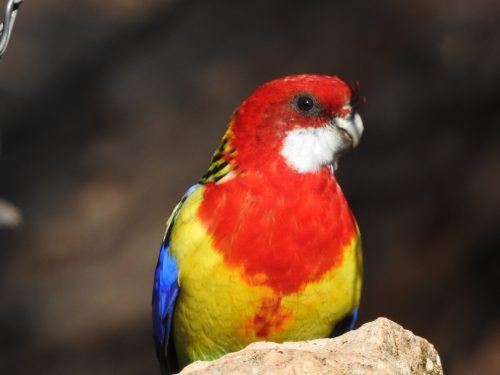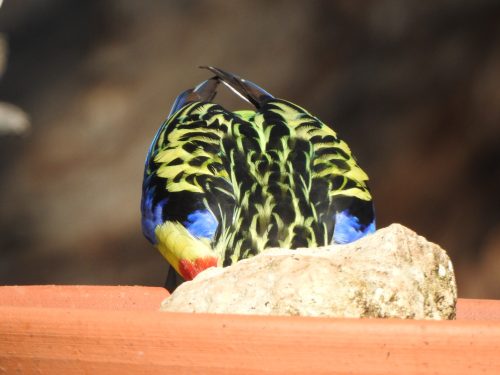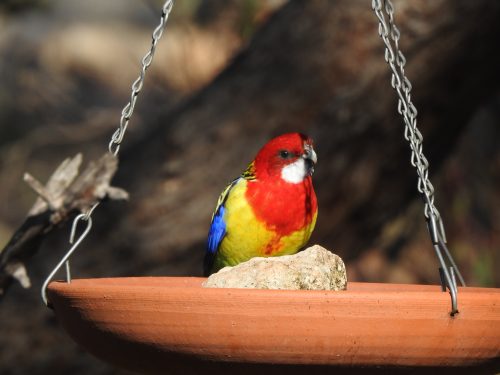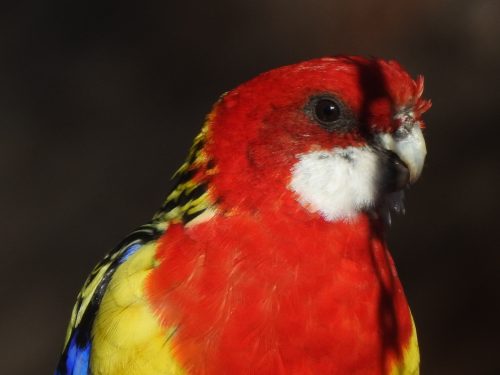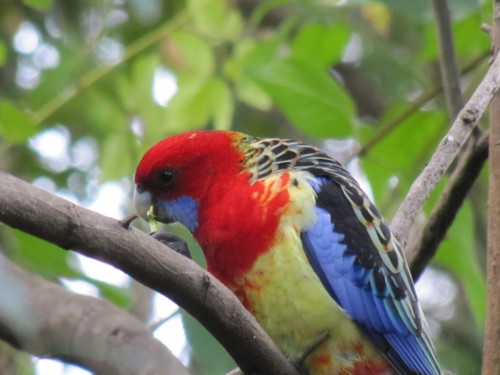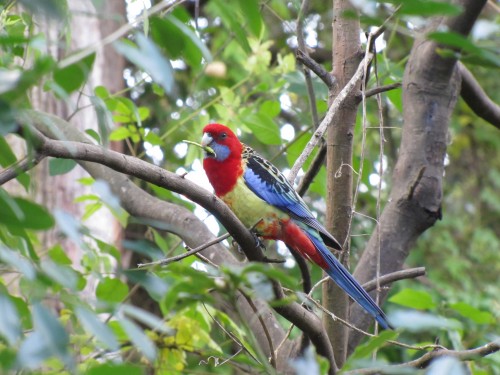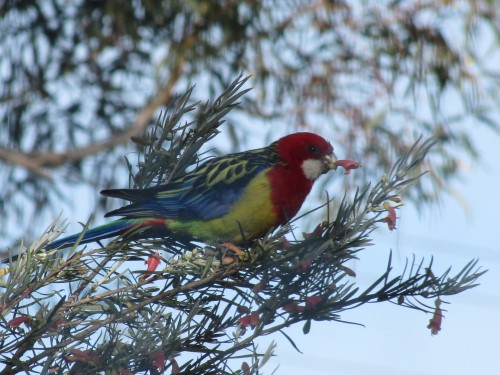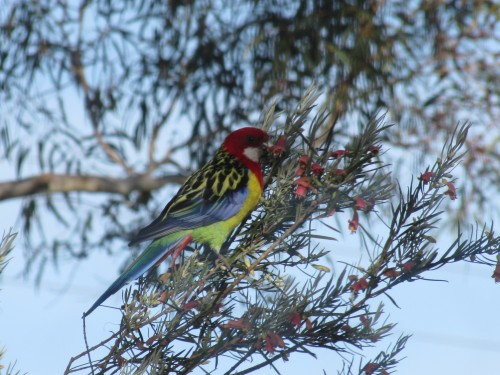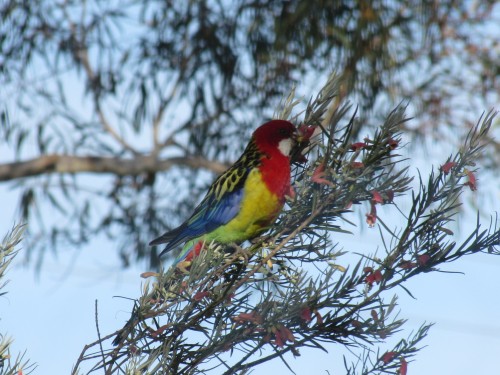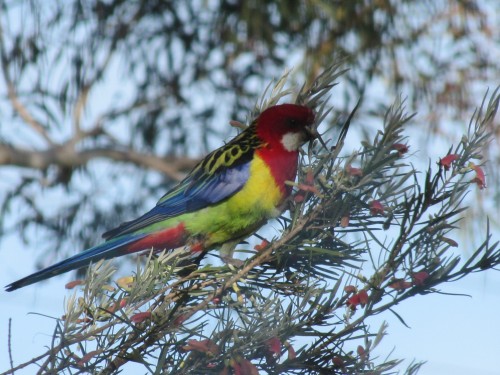The beautiful Eastern Rosella
The beauty of our Australian parrots never fails to impress me. One of the most beautiful to my eyes is the Eastern Rosella which I have featured in today’s photos. All of the photos shown in today’s post were taken in my garden on the outskirts of Murray Bridge which is about 80 kilometres south-east of Adelaide in South Australia.
This particular individual has been resident in my garden for several years now. I usually see it every day but I am sure that it roams over a much greater area than my 2 hectare (5 acre) property. One of the odd things about this bird is that it continues to keep the company of a family of Mallee Ringneck parrots. The ringnecks are also a resident species and they also roam away from my property most days. Some days they will hang around feeding in my trees for most of the day, sometimes creating quite a din with their noisy chatter.
One of the odd things about this rosella is that I am quite confident that it is the same one I am seeing all the time. They are not normally found in this part of South Australia. Their usual range is the extreme south-eastern part of our state. They are also quite common in the Adelaide region and the adjacent Adelaide Hills (Mt Lofty Ranges) where they have been introduced.
This leads me to two possible conclusions about this particular bird:
- It has escaped, or been released, from someone’s cage or aviary. (They are a common pet in Australia.)
- The species is extending its range, either from the south, or from the west.
I lean towards the first conclusion, mainly because I have not seen any more of this species anywhere around this area. Whatever the reason, I am delighted that it has decided to call my garden “home”. I am also pleased that it frequently visits the bird baths I have close to my sunroom. This enables me to get good photos of it every so often.
Up until this series of photos were taken, I hadn’t fully appreciated the beautiful markings on the back. The photo below shows these markings really well.
Good birding.
Further reading:
The beautiful Eastern Rosella
Earlier this year my wife and I had a day visit to the Lane Cove National Park. We were visiting our family for a few weeks and on this occasion we were free from grandparent duties.
Lane Cove National Park near Chatswood north of the Sydney CBD and is only about 15 minutes drive from my son’s home, so visiting is quite convenient. We went on a weekday, so there were only a few people around. Lunch time walkers, runners and cyclists made up the majority of visitors to the park.
As we were about to eat our lunch I noticed an Eastern Rosella fly in to a nearby tree. I steadily walked to within camera range and managed several good photos. Every time I see this species I marvel at the wonderful combination of colours.
Eastern Rosellas are quite common in the eastern parts of Australia. They are also present in the south east of South Australia and were introduced to the Adelaide region. We occasionally see one in our garden at Murray Bridge. It keeps company with the local Mallee Ringneck parrots. I’m not sure if this is a cage escapee or a case of their range steadily expanding.
Whatever the reason, we always enjoy seeing “our” rosella.
Now the Eastern Rosella is back home
For almost two years now we have had an Eastern Rosella occasionally visit our garden and patch of mallee scrub. During some weeks we see it several times a day, every day. On other occasions it may only visit once and then not again for a week or two. It is an unusual visitor for a number of reasons.
- Eastern Rosellas are not normally found in the Murray Bridge region. They are common in the eastern states and even in the south east of South Australia. They have been introduced to the Adelaide region. All I can assume is that this species is extending its range or this one bird has escaped from someone’s aviary – or has been released.
- The other unusual matter relates to its behaviour: it is regularly seen in the company of a Mallee Ringneck. We have up to a dozen ringnecks around at any one time, but most of them do not tolerate this “interloper” and will vigorously chase it off. It keeps returning; such persistence.
For the last month we hadn’t seen the rosella, but earlier this week it reappeared, again in the company of a ringneck and again being harassed by the other ringnecks. On Wednesday it posed nicely for my camera while eating the flowers of one of our Eremophila youngii bushes.
Further reading:
- Now we have two Eastern Rosellas
- Adelaide Rosellas in our garden
- Mallee Ringneck Parrot
- Parrots eating our flowers
- Eremophilas – articles about Eremophilas on my wife’s site.
Now we have two Eastern Rosellas
Over the last six months or so we’ve had an Eastern Rosella in our garden. It comes and goes but we see it most weeks. It appears to be trying to form a loose alliance with our resident Mallee Ringneck parrots, but they have consistently rejected his friendship.
The Eastern Rosella is a common bird in the eastern parts of Australia, and in the south-east of South Australia. It has been introduced to the Adelaide region. The nearest one I have seen was about 60km to the west. At first I thought that the bird visiting our garden was an aviary escape. A few days ago, however, I saw two of them flying away from our pear tree.
This caused divided feelings on my part.
- If this species is establishing itself in our town and its environs then this is a significant extension of its range, and this both interests and excites me.
- On the other hand, I felt annoyed because they had obviously been feeding on the near ripe pears in our orchard.
Oh dear, it seems that we can’t have both beautiful birds in our garden AND fruit on our trees.
Lunch time visitor: Eastern Rosella
While we were having lunch today I noticed a beautiful Eastern Rosella feeding on some flowers in our garden. I wasn’t quick enough to get a new photograph, so I’ve used one I took some months ago.
This bird has been hanging out with our resident Ringneck Parrots. It is not a species normally found in this part of South Australia, so I am assuming it has escaped from someone’s aviary. It has been resident in our garden for most of the year. I much prefer it flying around than in an aviary anyway.
